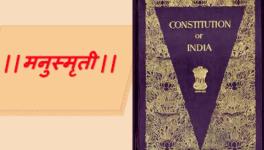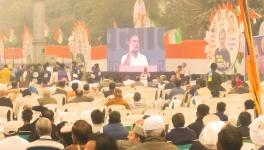Gandhi and Savarkar – A Study in Contrast
Mutual accusations and incrimination over whether Vinayak Damodar Savarkar lived up to the ‘Veer’ (Brave) moniker -- bestowed initially by admirers – or not, and if he was an unswerving nationalist or a weak-kneed apologist, has been exchanged across the primary ideological divide across India’s political terrain for several decades.
But, restricting the debate to questions regarding the authenticity of his ‘mercy’ petitions to the British and if he did so on the advice of Mahatma Gandhi or not, is testimony to our politicians’ – barring those from the Left – exceedingly poor understanding of history and Savarkar’s socio-political premise: Machiavellian and divisive to critics, but sincere and truthful for his admirers.
This has resulted in Savarkar not being put under a scrutinising spotlight and has allowed the current political regime to put him on a pedestal while arguing that his rightful place among the nation’s icons was denied by forces whose national commitment is ‘suspect’.
Let us examine a recent development and its fallout – Congress leader Rahul Gandhi raking up Savarkar’s mercy petitions and the pension he is said to have been granted by the British. Alongside, there is also necessity to recall Union Defence Minister Rajnath Singh’s claim made last year, that Savarkar sought clemency from the British in 1920 on the advice of Gandhi.
The facts are simple enough: VD Savarkar was arrested in London in 1910, deported to India under dramatic circumstances, and a year later sentenced to two separate life imprisonments subsequent to which he was deported to the Cellular Jail, Andaman Islands, where his brother Ganesh D Savarkar was already imprisoned since 1909 for the same ‘crime’.
Once jailed, Savarkar turned a prolific writer of mercy petitions starting with the first in 1911 and followed by others in 1912, 1914, 1916, 1918 and finally twice in 1920.
Phrases like, (I) "am ready to serve the Government in any capacity", (where else) “can the prodigal son return but to the parental doors of the Government", (seeking) "a last chance” to submit his case “before it is too late" and (his) "firm intention to abide by the constitution and stand by it," are strewn across his letters between 1911-1920 seeking leniency from the British government
Importantly, Gandhi was yet to return to India from South Africa when Savarkar wrote the first three of his petitions. Even on his homecoming in January 1915, Gandhi had, not only no occasion to engage with Savarkar, he also would not have been over-enthusiastic in meeting him again.
The two leaders of contrasting worldviews first met in London in the fall of 1909 when Gandhi visited England to lobby on behalf of Indian settlers in South Africa. Their meeting in the aftermath of Madan Lal Dhingra’s trial following the assassination of Curzon Wyllie by him brought out sharp divergences between the two.
So wide was the gulf that on his return to South Africa, when Gandhi wrote the book, Hind Swaraj, he wrote out a sequence of an ‘argument’ with an unnamed militant nationalist in the form of a dialogue, which many believed represented his conversation with Savarkar.
Gandhi had little doubt, and he wrote this in Hind Swaraj that “those who believe India has gained by Dhingra’s act” make a serious mistake. In contrast, Savarkar virtually played the role of ‘agent provocateur’ as revealed by his associate VVS Aiyer’s disclosure that Savarkar was, “the real guru (of Dhingra), the Avatar of Krishna."
In ways more than one, Dhingra was an ‘early’ Nathuram Godse-like Savarkar disciple, the difference being that while the former assassinated a British officer, the latter murdered Gandhi. The ‘catalysing agent’ for these two crimes, separated by 39 years was the same – Savarkar.
On his return to India, Gandhi would have had known that Savarkar considered violence as an essence of central feature of history and his political strategies, while Gandhi was of the view that depiction of violence in epics and legends are metaphors for internal conflict within humans and those engaging in violence are unable to control the phantoms within.
Importantly, stories abound about Gandhi’s religiosity while Savarkar is shown as an atheist to project him as an epitome of rationality. But while Gandhi called for politics to be founded on deeply entrenched religious ethics, Savarkar injected political militancy into religious identities.
It is important to situate the occasion when Gandhi ‘advised’ Savarkar in January 1920 amid the sequence of events occurring in that period. This episode was preceded by several events, most notably the nation’s plunge into turmoil following the uncalled for enactment in March 1919 of the Rowlatt Act, indefinitely extending the government’s repressive emergency powers.
The Jalianwala Bagh massacre to suppress people’s protest against the draconian law further pushed India down the crevice. Colonial administrators remained unrepentant: persisted with repression in Punjab, Hunter Commission remained set on a predetermined course, and the government stayed firm on not yielding ground despite nationalist opposition to constitutional reforms of 1919.
To protest these developments, the call for non-cooperation received support from delegates at the Indian National Congress session in Amritsar in December 1919. By then, Gandhi had already joined the Khilafat movement launched by prominent Muslim leaders, indicating efforts being made to forge pan-Indian unity cutting across communities, opinions and political groups.
Gandhi embarked on providing a mass character to the national movement; it was thus necessary to widen the platform and form strategic alliances with different groups and communities.
In this backdrop Gandhi received a letter from Narayan D Savarkar, younger brother of the two jailed siblings. Although Gandhi was frank in writing back that it was “difficult to advise you,” he suggested “framing a brief petition setting forth the facts of the case bringing out in clear relief the fact that the offence committed by your brother was purely political.”
It is often missed amid the din over Savarkar’s petitions that Narayan D Savarkar pleaded with the British regime for “at least a change to some Indian jail of better climate.”
Gandhi’s next intervened on easing Savarkar’s situation in May 1920 in the form of an article in Young India.
Articulate lawyer that he undoubtedly was, Gandhi first quoted the Royal Proclamation dated December 1919, which provided clemency for “political offenders” who broke laws previously but would henceforth pledge to “respect it in the future.”
Gandhi pointed out that political prisoners included “Savarkar brothers” and they remained in jail although “five months have gone by after the publication of the Proclamation.”
Writing of VD Savarkar and his elder brother, Ganesh, Gandhi wrote: “Both these brothers have declared their political opinions and both have stated that they do not entertain any revolutionary ideas and that if they were set free they would like to work under the Reforms Act, for they consider that the Reforms enable one to work thereunder so as to achieve political responsibility for India.”
Gandhi was unequivocal in his understanding that the brothers "feel that India’s destiny can be best worked out in association with the British." Gandhi’s commitment to non-violence is evident in his claim that “the cult of violence has, at the present moment, no following in India.”
Viewed from Gandhi’s perspective, his call for clemency for the Savarkar brothers was a ‘victory’ because from being a guru of Dhingra, the younger (VD) Savarkar was committing to a path of non-violence.
By writing to Narayan D Savarkar or in his journal, Gandhi did not condone previous mercy petitions – he, in fact, glossed over these because of his political motivations in collecting nationalists of all hues on a non-violent platform prior to the launch of the first mass agitation against the British in September 1920.
This episode in fact, demonstrates Gandhi’s large heartedness and political inclusivity, for he set no conditions to make a plea on behalf of Savarkar and his elder sibling.
On the contrary, the moment VD Savarkar was shifted out of Cellular Jail to prisons in Maharashtra he embarked on writing what eventually became the seminal text of the Hindutva ideology – ‘Hindutva: Who is a Hindu?’ – which inspired KB Hedgewar at the same time to establish the Rashtriya Swayamsevak Sangh.
Under ‘detention’ in Ratnagiri, although he was not lodged in jail, Savarkar wrote copiously. Since he was disallowed to write on politics, he camouflaged his polemical works with thinly veiled fictionalised narratives. Much of this was extremely violent in nature; in fact, violence, vendetta and vindictiveness formed major themes of his writing.
In contrast to Gandhi’s emphasis on non-violence in his political thoughts and action, Savarkar insisted that violence was an integral element of “Hindu civility”, to borrow a phrase from Vinayak Chaturvedi, author of Hindutva and Violence, a comprehensive analysis of Savarkar’s ‘oeuvre’.
It is time that critics of Hindutva politics shift their attacks on Savarkar from his mercy petitions, to what he wrote and preached. They need to argue that Savarkar was a complete contrast to not just Gandhi but all adherents of inclusive nationalism and exclusions that Savarkar insisted on were intrinsically violent.
There is need to challenge the belief in liberal and progressive circles too that pre-Andaman Savarkar was an epitome of inclusive nationalism and that he believed in necessity and forging commonality of political purpose between Hindus and Muslims as evidence in his 1909 book on the 1857 events.
Adversaries of Bharatiya Janata Party must comprehend that the facet of Savarkar which Gandhi encountered in 1909 provided inspiration not just for Dhingra who embraced the cult of assassination, but also the later assassins, Godse included.
The foundation of BJP’s emergence as a political hegemon has been cemented by violent politically backed episodes of history; the Ram Janmabhoomi agitation in the late 1980s and early 1990s and thereafter the 2002 Gujarat pogrom.
Both episodes were justified on the basis of the argument that Hindus will no longer ‘accept humiliation meekly but would hit back with vengeance’. Almost every senior leader justified the Ayodhya agitation and the demolition.
Likewise, the 2002 riots were reasoned as a natural outcome of the Godhra carnage. Both sets of arguments drew on Savarkar’s premise that not ‘reacting to provocations’ would mean being un-Hindu.
Disgrace and dishonour, if not found readily in the present context, can always be found in history. These were the primary postulates of Savarkar and explain why elevating him as the tallest Indian ‘nationalist’ ideologue is essential to the politics of Sangh Parivar.
Paradoxically, violence has been embedded in national political responses even while lip-service is paid to the Gandhian principle of non-violence.
Not decoding Savarkar and unmasking the real ‘Veer’ will eventually result in the Opposition finding no escape from lionising him too.
Just as now there is no avoiding the deification of Ram from an epic hero to a god epitomising the spirit of the nation, Savarkar will soon become one whose memory and image will be placed alongside Gandhi, if not above him, and be considered a ‘founding father of national consciousness’.
The writer is a NCR-based author and journalist. His latest book is The Demolition and the Verdict: Ayodhya and the Project to Reconfigure India. He has also written The RSS: Icons of the Indian Right and Narendra Modi: The Man, The Times. He tweets at @NilanjanUdwin. The views are personal.
Get the latest reports & analysis with people's perspective on Protests, movements & deep analytical videos, discussions of the current affairs in your Telegram app. Subscribe to NewsClick's Telegram channel & get Real-Time updates on stories, as they get published on our website.























